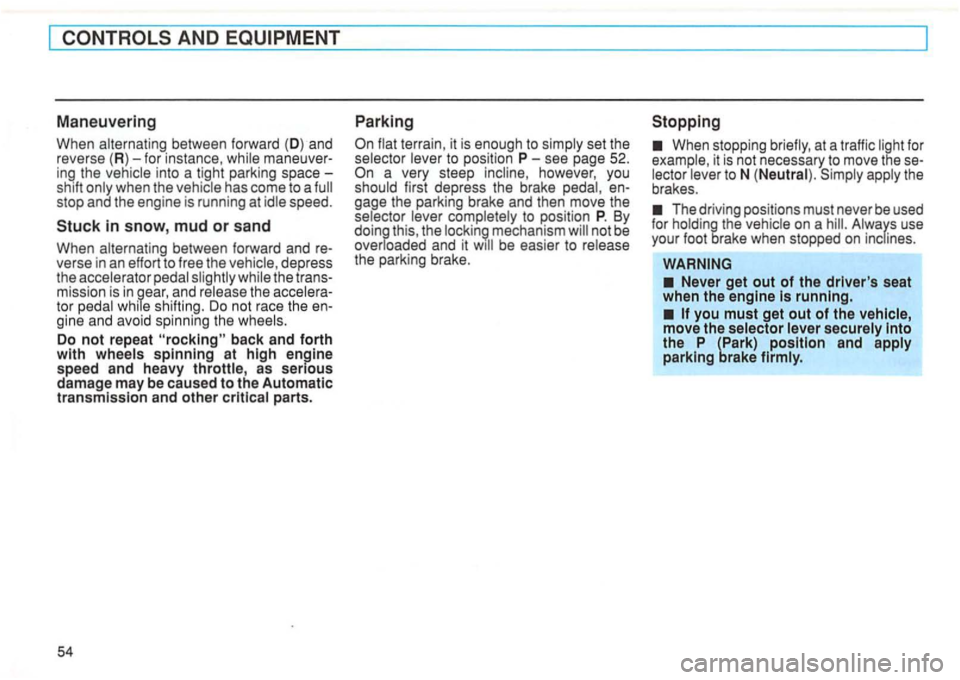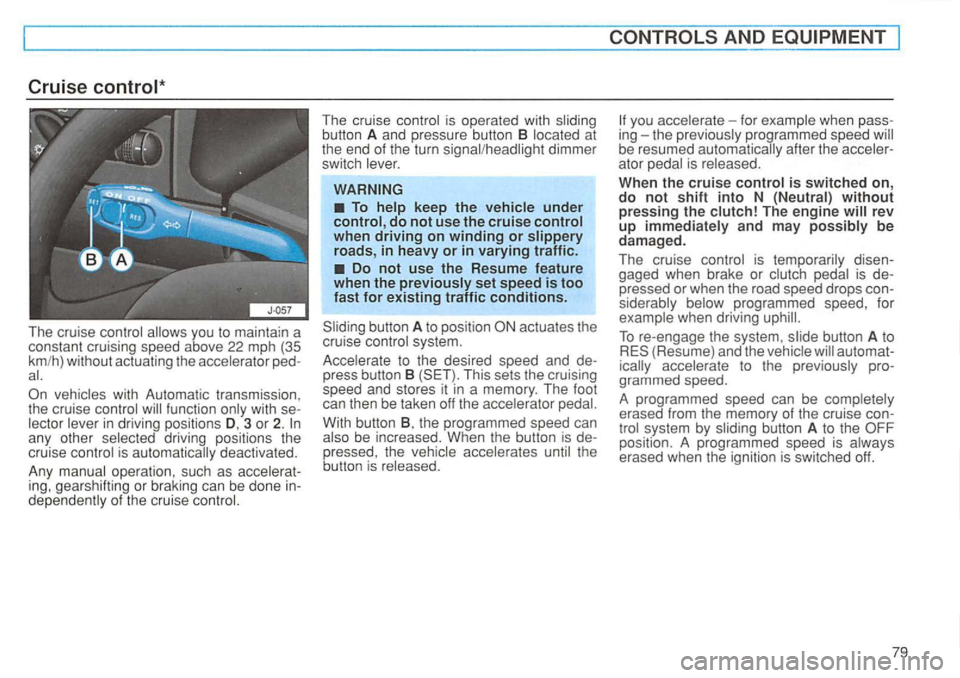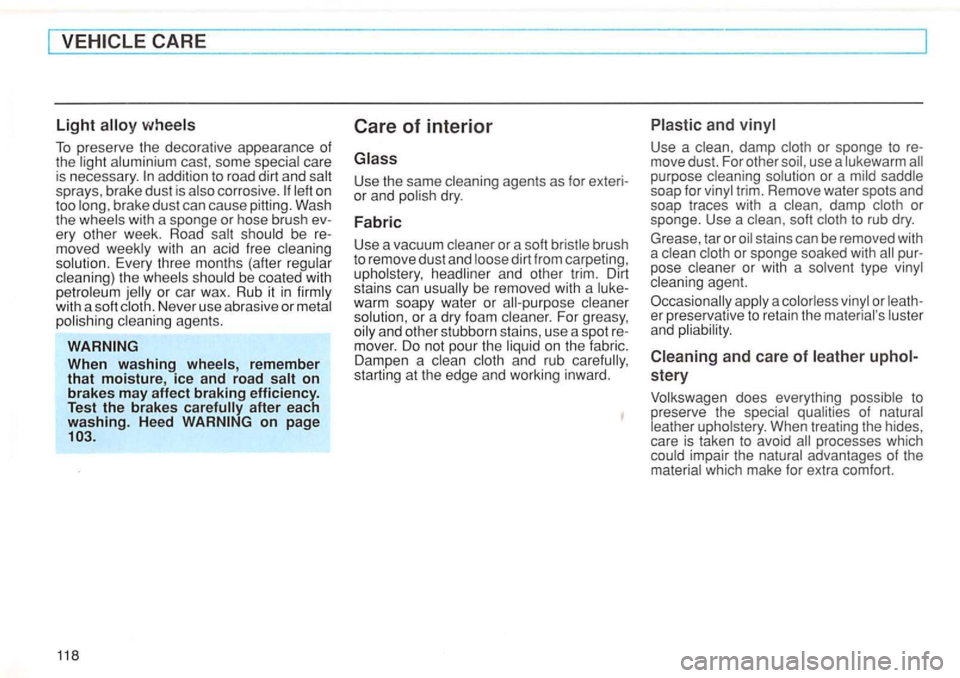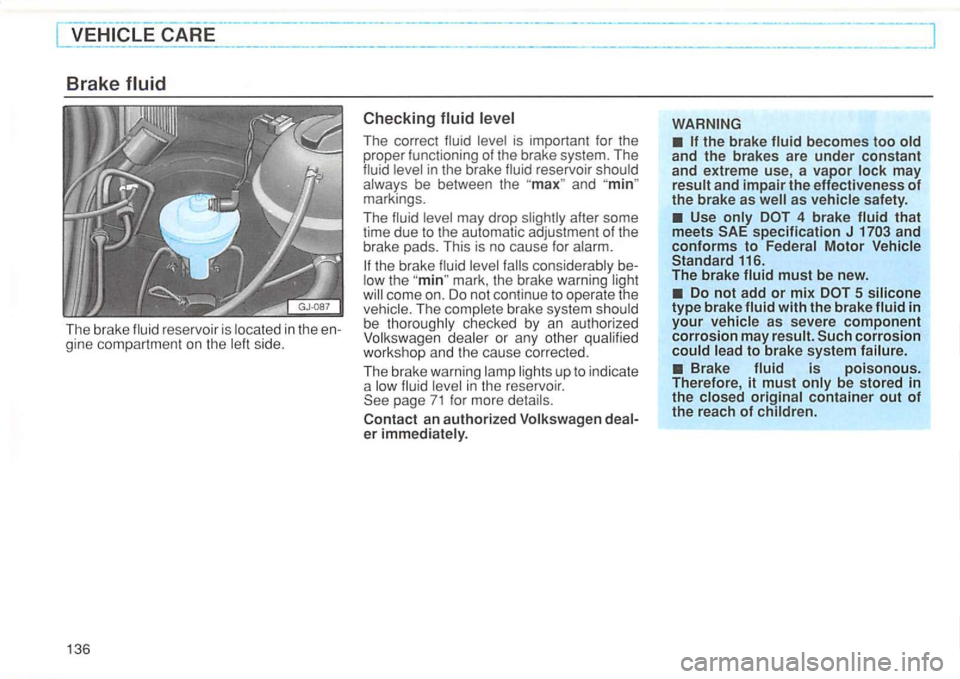Page 11 of 274
Airbag system High beam 71
temperature 69
Generator Turn
pressure 69 71
BRAKE or Brake 71 CHECK Light
Page 53 of 274
AND
case one of the two brake circuits fails,
increased brake pedal travel is required to
bring the vehicle
to a
You shoul d always be able to depress
the acce lerato r and the clutch pedals the
way down to the
use floor mats which the
The parking brake is located between
t he front seats.
up
tion is on, the brake warning light light up.
Depress brake pedal and whil e leasing parking brake. To release the ing brake , pull the lever slightly up, depress the release button (a rrow) , and then push the lever the way down . When the ing brake is released , the brake warning
light go out.
WARN ING
overheat
the rear brakes , reduce their effective ness an d cause excessiv e
wear .
(Automatic transmi ssion) or move the gearshift lever to or ( man ual transmission) . also turn the
w hee ls t oward th e curb.
Page 57 of 274

stop and the engine is running at id le speed.
Stuck in snow, mud or sand
When alternating between forward and re
verse in an effort to free the vehicle, depress
the accelerator pedal slightly while the tran
smiss ion is in gear, and release the accele ra
t o r p ed al whi le sh ifti ng. D o not race th e engine a nd avo id spinni ng th e wheels.
Do
not repeat back and forth with wheels spinning at high engine
speed and heavy throttle, as serious damage may be caused to the Automati c transmission and othe r crit ical parts.
54
Parking
a very steep incline, however, you
should first depress the brake pedal, en
gage the parking bra ke and the n move the
selector lever completely to posit ion P. By
do ing
this , the mechanism and it be easier to rele ase
the park ing brake .
Stopping
When stopping briefly, a t a traffic light for
example , it is not necessary to move these
l ec t
or lever to N (Neutra l).
The driving pos itions must never be used
for holding the vehicle on a hill. Always use
your foot brake when stopped on inclines.
Page 82 of 274

The cruise control
any other selected driving positions the
cr uise control is
of the cruise
The cruise control is operated with sliding
button A and pressure button 8 located at
the end of the turn signal /headlight dimmer switch lever.
To keep the under do not use the cruise when driving on winding or roads, in heavy or in varying traffic.
Do not use the Resume feature
when the previou sly set speed is too
fast for existing
conditions .
With button 8, the programmed speed can
also be increased. When the button is de
pressed , the accelerates until the
button is released.
AND
you acce lerate-for example when pass
ing -the previously programmed speed
be resumed automatically after the acceler
ator pedal is rel eased .
When the cruise control is switc hed on,
do not s
hift into N (Neutral ) withou t
pressing the clutch! The engine rev
up immediately and may possibly be damaged.
The cruise control is tempora rily disen
gaged when brake or
(Resume ) and the vehicle automataccelerate to th e previously pro
grammed speed.
A programmed speed can be completely
erased from the memory of the cruise con
trol system by s liding button
A to the
Page 98 of 274
Operate your
points before you drive off:
Adjust the mirrors
between
the engine hood and the windshield is free of leaves , snow and ice
for changing the
brake see page137.
Your personal
driving style as
Wear your safety belts, even if you are just driving in the city -
see page
passengers are
wearing their safety belts, even those sitting in the rear-see page
Passengers not wearing safety endan
ge r not only themselves in case of an accident, b ut also the driver and other
Adjust your seat so that you can easireach
Store luggage and light items prop
panel -
s ee page 49.
on top of the roof-see page 93.
95
Page 109 of 274
The contributes effectively to vehicle
control since it prevent s th e wheels from
locking when the brakes are applied. This
means
that the vehicle remains steerable and is less inclined to skid.
Note
You
don' t have to the brake . Just hold the brake pedal down.
How ever,
do not expect that the
stances. When driving on gravel or on newly
fallen snow on top of icy surfaces, braking
distance may be even longer, therefore,
portant that you drive slowly and with great
care.
How the system works
An automatic check is made when a speed
of approx. 4 mph (6 km/h) is reached. When
this happens a pumping noise can be heard.
an individual wheel begins to rotate too
s lowly in rela tion to vehicle speed and tend to lock, the aut omatically reduces
brake pressure to prevent that wheel from
l ocking. This
autom
atic adj ustment process will cause a slight vibration of the brake al and some noises to alert you that
Page 125 of 274

To preserve the decorative appearance of
the light aluminium cast, some special care
is necessary.
addition to road dirt and on
too b rake dust can cause pitting. Wash
the wheels with a spon ge or hose brush ev
ery othe r week . Road should be re
moved weekly with an acid free cleani ng
so lution . Eve ry thr ee months
(after reg ular
cleaning) the wheels should be coate d with
petroleum
remember
that moisture , lee and road on
brakes may affect braking efficiency.
Test the brakes
118
Care of interior
Use the same cleaning agents as for exteri
or and polish dry.
Fabric
Use a vacuum or a soft bristle brush
to remove dust and dirt from carpeting,
up hol ster y, headliner and other trim. Dirt
stains can
be removed with a luke
warm soapy water or clea ner
s olution , or a dry foam cleane r. For greasy,
a nd other stub born stains, use a spot re
mover. Do not pour the liquid on the fabric.
Dampen a
and rub starting at the edge and working inward.
Use a damp or sponge to re
move dust. For other use a lukewarm purpose cleaning solution or a saddle
soap for trim. Remo ve water spots and
soap traces with a clean , damp
soft to rub dry.
Grease , tar or
stain s can be remo ved with
a or sponge soaked with pur
pose
age nt.
or leath
er preservative to retai n the mate rial's lu ster and pli ab ility.
and care of
Page 143 of 274

Brake fluid
The brake fluid reservo ir is located in the en
gi ne compa rtment o n th e left side .
136
----------------
Checking
The correct fluid level is importa nt for the
proper functioning of the brake system. The
fluid level
in the brake fluid reservoir should
always be between the and markings.
The fluid level may drop slightly
some
time due to the automatic adjustment of the
brake pads. This is no cause for alarm.
mark , the brake warning light come o n. Do not continue to operate the
v ehicle . The comp le te brake system shou ld
be thoroughly checked by an authoriz ed
Volk sw age n dea l
er or any other qualified
workshop and the cause corr ecte d.
The brake warning lamp lights up
to indicate
a low fluid leve l in the reservoir.
Use only 4 brake fluid that meets SAE specification J and conforms to Federal Motor Vehicle
Standard 116.
The brake
fluid must be new .
Do not add or mix
Brake fluid is poisonous. Therefore , it must only be stored in the closed original container out of the reach of children.
J